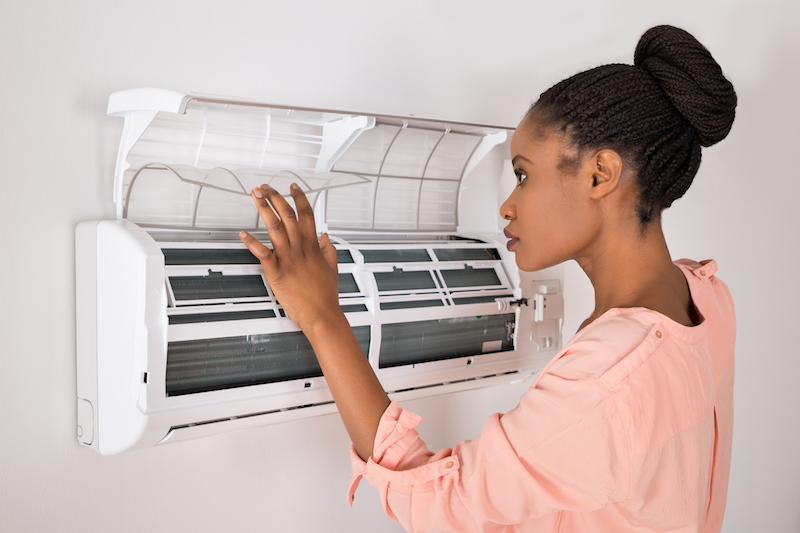
You shouldn’t need to compromise on comfort or drain your wallet to keep your residence at a refreshing setting during the summer.
But what is the best setting, exactly? We discuss suggestions from energy experts so you can choose the best temp for your home.
Here’s what we suggest for the most energy-efficient setting for air conditioning in Columbia.
Recommended Thermostat Settings for Summer
Most households find setting the thermostat at 72-73 degrees is most comfortable. However, if there’s a huge difference between your interior and outdoor temperatures, your electrical costs will be greater.
These are our recommendations based on the U.S. Department of Energy (DOE) and ENERGY STAR®.
While at home: 78 degrees. While that sounds hot, there are approaches you can keep your home refreshing without having the air conditioner going all the time.
Keeping windows and window treatments closed during the day keeps cold air where it should be—indoors. Some window treatments, including honeycomb shades or plantation shutters, are made to provide more insulation and enhanced energy efficiency.
If you have ceiling fans in your residence, the DOE says you can move thermostat settings about 4 degrees warmer without giving up comfort. That’s since they freshen with a windchill effect. Because they cool people, not rooms, shut them off when you move from a room.
If 78 degrees still seems too uncomfortable on the surface, try running an experiment for approximately a week. Begin by upping your temperature to 78 degrees while you’re at your residence. Then, steadily turn it down while following the ideas above. You may be amazed at how refreshed you feel at a hotter temperature setting.
While away: 88 degrees. There’s no need to keep the air conditioning working all day while your residence is vacant. Switching the temp 7–10 degrees warmer can save you an estimated 5–15% on your AC expenses, according to the DOE.
When you arrive home, don’t be tempted to switch your thermostat colder than 78 to cool your home faster. This isn’t productive and typically produces a higher electricity cost.
A programmable thermostat is a helpful method to keep your temp controlled, but you need to set programs. If you don’t use programs, you run the risk of forgetting to raise the set temperature when you go.
If you’re looking for a handy solution, think about buying a smart thermostat. This thermostat connects with your phone, so it knows when you’re at your house and when you’re gone. Then it intuitively changes temperature settings for the best savings. How much exactly? An estimated $180 annually on heating and cooling, according to ENERGY STAR.
Another perk of getting a smart thermostat? You can use your phone to keep an eye on and adjust temperature settings from just about anywhere.
While sleeping: Around 70 degrees. While ENERGY STAR advises 82 degrees, that could be unbearable for most families. Most people sleep better when their sleeping space is chilly, so that’s why the National Sleep Foundation suggests 60–67 degrees. But that may be too cold, due to your pajama and blanket preference.
We recommend using a comparable test over a week, putting your temperature higher and slowly turning it down to locate the right temp for your house. On cool nights, you could find keeping windows open at night and using a ceiling fan is a preferable solution than running the air conditioning.
More Ways to Save Energy During Hot Weather
There are extra approaches you can spend less money on energy bills throughout warm weather.
- Buy an energy-efficient AC system. Central air conditioners only last about 12–15 years and become less efficient as they age. An updated air conditioner can keep your residence more comfortable while keeping electrical costs low.
- Set yearly air conditioner maintenance. Routine air conditioner maintenance keeps your equipment running properly and may help it work at greater efficiency. It can also help prolong its life expectancy, since it allows pros to uncover small problems before they lead to a major meltdown.
- Change air filters regularly. Use manufacturer instructions for switching your air filter. A clogged filter can result in your system short cycling, or turn on and off too frequently, and drive up your electricity.
- Measure attic insulation levels. Just about 90% of residences in the USA don’t have enough insulation, according to the Insulation Institute. Most southern climates require 13–14” of attic insulation, while northern climates should have 16–18”.
- Have your ductwork examined. Ductwork that has come apart over time can seep conditioned air into your attic, walls or crawl space. This can result in big comfort issues in your home, such as hot and cold spots.
- Seal openings, doors and windows. Keep warm air where it belongs by sealing openings. You can also caulk or weather strip doors to keep more cool air inside.
Save More Energy During Hot Weather with Watts Electric & AC
If you want to use less energy during warm weather, our Watts Electric & AC experts can provide assistance. Give us a call at 601-736-7362 or contact us online for additional information about our energy-saving cooling solutions.
